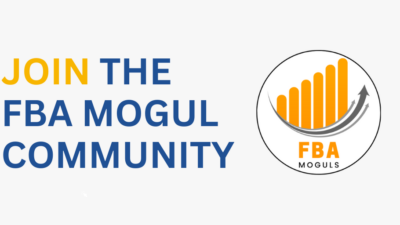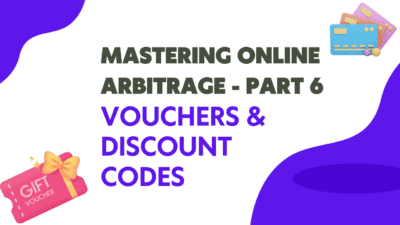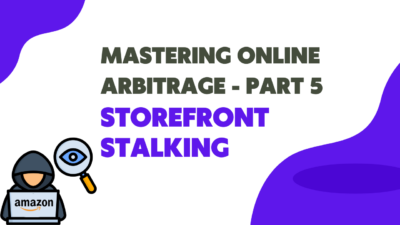Introduction
Welcome, Future Amazon Seller! 🚀
This guide is designed to take you from zero to a successful Amazon FBA seller in the fastest and most stress-free way possible.
My name is Simon (FBAMogul on YouTube), and I’m a seven-figure Amazon seller based in the UK. My mission is to help as many people as possible get started with Amazon FBA and replicate my success.
I began selling in July 2022, and since then, I’ve generated over £200,000 in profit—and growing! I now consistently make over £10,000 per month, with my best months far exceeding that.
As soon as people started to see my success they began to ask if I could help them. So I decide to start a YouTube channel where I can distill all my knowledge about Amazon. I also created a free community for Amazon sellers – Join it here
Since then I have helped hundreds of people start their own Amazon FBA business and I’ve come to truly believe that Amazon FBA is one of the best business opportunities for anyone looking to start their own business, whether it’s to earn extra income on the side or completely replace their full-time job.
So what are you waiting for? Lets’ get started.
1. What is Amazon FBA and why is it such a great opportunity?
Amazon FBA (Fulfillment by Amazon) is a service offered by Amazon that allows sellers to store their products in Amazon’s warehouses and sell on Amazon’s website. Amazon handles the storage, packaging, shipping, customer service, and returns for those products. This model has become a popular choice for e-commerce entrepreneurs due to its scalability and efficiency.
How Amazon FBA Works In a Nutshell
- Send Inventory to Amazon: Sellers ship their products to Amazon’s fulfillment centers.
- Product Listing: Sellers list their products on Amazon’s marketplace.
- Storage: Amazon stores the products in its warehouses.
- Customer Orders: When a customer places an order, Amazon picks, packs, and ships the product directly to the customer.
- Customer Service & Returns: Amazon handles customer inquiries and product returns, reducing the seller’s workload.
Why Amazon FBA is a Great Opportunity
1. Access to Amazon’s Infrastructure
- Sellers leverage Amazon’s extensive fulfillment network, saving the cost of creating and maintaining their own logistics system.
- Amazon’s fast shipping options, including Prime, appeal to customers.
2. Massive Customer Base
- Amazon is one of the largest online marketplaces, with millions of active shoppers globally.
- Sellers gain access to this vast audience without needing to build their own traffic or brand.
3. Hands-Off Fulfillment
- Amazon takes care of logistics, allowing sellers to focus on product sourcing, marketing, and business growth.
- This makes it ideal for solo entrepreneurs or small businesses with limited resources and time.
4. Enhanced Trust and Credibility
- Products fulfilled by Amazon often receive the Prime badge, which boosts trust among customers and can lead to higher conversion rates.
5. Scalability
- FBA allows businesses to scale without worrying about the complexities of warehousing and shipping.
- Sellers can grow their inventory and expand their product range more easily.
6. Global Reach
- Through FBA’s international programs, sellers can reach customers in multiple countries with minimal additional effort.
7. Simplified Customer Service
- Amazon handles customer support, including inquiries, refunds, and returns, which can be a major time-saver.
I made a video talking about why Amazon is such a great opportunity. You can watch that here:
2. Join My Free Amazon Community
You’re incredibly fortunate to have access to my 100% free Amazon FBA community, where you can learn, get expert help and advice, connect with like-minded sellers, and be part of a supportive and thriving network of Amazon entrepreneurs.
The community is called FBA Moguls and has over 1000 like minded members who are all working together to start and improve their Amazon businesses.
To join use the link below
3. Sole Trader vs LTD Company
Wow here we are, the first step to creating your future business empire! Congratulations for making it this far!
The first thing you are going to need to decide is if you want to start off as a sole trader or go staight into being a LTD company.
I have done a video explaining the differences here:
My general opinion is to start off as a sole trader and then move to a LTD company once you are happy with the business. The main reason for this is starting a LTD company is a little bit more serious and comes with some extra admin work you need to do with HMRC etc.
I have high hopes you will be successful in this business, but if you decide that this business is not for you then it is much easier to stop trading and wrap things up as a sole trader vs doing it as a LTD company where you have to file accounts and dissolve the company. However at the end of the day the choice is your’s and it is always worth consulting an accountant if you are unsure.
4. What You Need To Start
Before we go ahead and create your Amazon account there are a few things we are going to need to setup first.
✅ Email Address – Preferably one dedicated to your Amazon business.
✅ UK Phone Number – Required for verification.
✅ Government-Issued ID – Passport or driver’s license for identity verification.
✅ Brand new & seperate bank account – Sign up to Tide bank here and get £50 free
✅ Proof of Address – A recent utility bill or bank statement (matching your name and address).
✅ UTR/Company registation number – For taxes & business verification
✅ Capital – A minimum of £500-£1000 budget (More the better)
5. Create Your Amazon Account
The next step is to actually create your Amazon seller account. You need to go to this link and create your account.
It is important to know that you may only have one Amazon seller account, so do make sure you do not have an existing seller account. Amazon are very strict about this and may ban you if you have multiple accounts.
Step 1: Choose Your Selling Plan
Amazon offers two types of seller accounts in the UK:
• Individual Plan – £0.75 per item sold (best for beginners selling fewer than 35 items per month).
• Professional Plan – £25 per month (best for those selling over 35 items per month, with access to advanced features like bulk listings and advertising).
💡 Tip: If you’re serious about selling on Amazon, the Professional Plan is highly recommended.
6. Essential Software
Amazon FBA is one of those businesses that requires you to have a few bits of software to succeed. Eventually you will end up with 4-5 bits of software but right now we just need to set you up with the essentials.
✅ SellerAmp – SellerAmp is software that assists with analysing products/deals you find and lets you know if they will be profitable or not. For one subscription you get both a mobile app for going out into physical stores and a chrome extension to analyse online deals.
You can signup for a 14 day free trial using my link here
✅ Seller ToolKit – Seller Toolkit is an all-in-one Amazon seller software that helps UK and EU sellers track profits, manage inventory and optimize their Amazon FBA business efficiently.
You can signup for a 14 day free trial using my link here
7. Amazon Seller Equipment
Here’s a list of essential equipment, along with some optional tools, to help you run a successful Amazon FBA business.
The reason you need this as you will be required to do some prep work to your items before you can send them into Amazon. Having this equipment will save you a bunch of time and headache.
Essential Equipment
Label Printer – I have two of these, one for the 4×6 shipping labels and one for the SKU labels.

Another alternative Label Printer – Another option if the first one is unavailable.

Label Holder – A holder for your shipping and SKU labels.

SKU Labels – I use these for SKU labels to cover the manufacturer barcode

Other Alternative SKU labels – Another option if the first one is unavailable.

4×6 Shipping Labels – Used for UPS shipping label

Boxes – I use 610 x 457 x 457 mm. These are great because they can be easily cut down to size if needed.
Medium Poly Bags – Various sizes here, but here is a medium sized Poly bag (Good for toys, larger cosmetic items etc). Sized 28cm x 36cm (11″ x 14″)

Small Poly Bags – Various sizes here, but here is a small sized Poly bag (Good for small cosmetic items). Sized 18cm x 21cm (7″ x 8″)

Packing Tape – Essential to get a bunch of rolls, always useful and quite cheap
Tape Gun – Saves so much time packing boxes with this tape gun
Optional Equipment
A4 SKU Labels – Use these if you have existing ink jet / laser printer and don’t want to commit to a thermal printer just yet
Barcode Scanner – I use this to make it easier to scan products and build out shipments
Document Scanner – Not critical but makes it easier to scan invoices/receipts.
8. 🎉 Congratulations on Starting Your Amazon FBA Journey! 🎉
You’ve taken the first step toward building a successful online business—and that’s huge! 🚀 Stay focused, keep learning, and take action. Success in FBA comes with consistency and smart strategies.
I’m excited to see your progress—let’s make this a profitable journey together! 💰🔥
Now lets get dug in and take the next steps in your journey!
9. Understanding The Different Business Models
1. Retail Arbitrage (RA) 🏪
Retail Arbitrage involves buying discounted products from physical retail stores (e.g., Tesco, Argos, B&M) and reselling them on Amazon for a profit.
✅ Pros:
• Higher profits – Retail arbitrage deals tend to have higher profits
• Quick to start – You can find products and list them the same day.
• Easy to learn – Great for beginners testing the FBA model.
❌ Cons:
• Time-consuming – Requires visiting multiple stores to find profitable deals.
• Limited scalability – Harder to scale compared to other models.
• Inconsistent stock – Retailers may run out of profitable products.
2. Online Arbitrage (OA) 💻
Online Arbitrage is similar to RA, but instead of going to physical stores, you buy discounted products from online retailers (e.g., Argos, John Lewis, Tesco) and resell them on Amazon.
✅ Pros:
• Work from anywhere – No need to visit physical stores.
• Scalable – You can source products from multiple websites.
• Access to cashback & discounts – Use cashback sites, discount codes, and gift cards to increase profits.
❌ Cons:
• Competition – Other sellers might be sourcing from the same online stores.
• Longer shipping times – You must wait for products to arrive before sending them to Amazon.
• Bulk Ordering – Some online retailers cancel bulk orders, affecting sourcing consistency.
3. Wholesale 🏢
Wholesale involves buying products in bulk directly from brands or distributors at wholesale prices and reselling them on Amazon.
✅ Pros:
• More stable business model – Consistent access to inventory.
• Scalability – Easier to increase sales volume.
• Direct supplier relationships – Better pricing and potential exclusivity deals.
❌ Cons:
• Higher upfront investment – Requires bulk purchasing.
• Brand restrictions – Some brands don’t allow Amazon resellers.
• Hard to find – Its extremely time intensive and difficult to find great wholesalers
4. Private Label (PL) 🔥
Private Label is when you create your own branded product by sourcing from manufacturers (e.g., in China via Alibaba) and selling it under your own brand name on Amazon.
✅ Pros:
• Higher profit margins – No direct competition on your listing.
• Brand control – You own the product and can differentiate it.
• Scalability – Potential to grow into a long-term brand.
❌ Cons:
• Higher startup costs – Requires investment in branding, packaging, and marketing.
• Longer time to launch – Product sourcing, manufacturing, and listing optimization take time.
• Risk of failure – Choosing the wrong product can result in losses.
5. Amazon to Amazon (A2A) 🔄
Amazon to Amazon Arbitrage (A2A) is a sourcing method where sellers buy products at a lower price from Amazon (often during sales, discounts, or when prices drop temporarily) and then resell them back on Amazon at a higher price.
✅ Pros:
• No need to source from multiple retailers – Everything is done on Amazon.
• Easy Money – Items arrive fast and then can go back into Amazon.
• Great for price drops – Buy when prices are low, then sell when they return to normal.
❌ Cons:
• Limited stock availability – Amazon may restrict purchase quantities on discounted products.
• Hard to do alone – You need a bot/monitor to look for and find deals.
Which Model is Best for You?
• Beginners → Start with RA or OA (low investment, easy to learn).
• Intermediate sellers → Amazon To Amazon / Wholesale (more stability, better pricing).
• Advanced sellers → Wholesale / Private Label (higher profits, brand control).
Each model has its own strengths and weaknesses. I personally beleive a new seller should stick to OA, RA, and potentially A2A. Forget about wholesale and private label for now, think about them again after a year or so of selling.
9. Sourcing Methods For Beginners
Now you have a good understanding of the different main business models for Amazon FBA, we can focus on actually sourcing products.
Sourcing is the most important part of this business, it is also the hardest part to learn. There are no real shortcuts, you need to practise, practise and practise some more to get good at sourcing.
There are some softwares that can help, but we will stick to manual sourcing for now and discuss those softwares a bit later.
The main focus for this guide is going to be teaching you how to source OA (Online Arbitrage) as I think this is generally the best model for beginners. We will also dabble into A2A and RA as well a bit later on.
As a general rule, we are always looking to buy items that are on sale/discounted compared to their normal price. I would say 99% of products we buy to sell on Amazon are bought during some kind of promotional period / using a discount code.
1. Newsletter Sourcing
Newsletter sourcing involves subscribing to retailers newsletters to get an insight into sales, exclusive deals and discounts they are offering. The main reason for using newsletter is to identify when a sale/discount/promotion is happening on a site. This then directs our attention to that site and gives us the best chance of finding a profitabe deal for Amazon.
How to Source via Newsletters
Step 1. Sign Up for Online Retailers Newsletters
You need to spend some time signing up to a bunch of different newsletters
Step 2. Monitor Weekly & Monthly Promotions
• Look for limited-time discounts and overstock sales.
• Suppliers may notify subscribers first about new product releases.
3. Compare Prices on Amazon
• Before purchasing, run numbers using Keepa and SellerAmp SAS.
• Check the Buy Box price, historical trends, and estimated monthly sales.
Pros & Cons of Newsletter Sourcing
✅ Pros:
• Access to exclusive deals and early product drops.
• Can secure discounted stock before competitors.
❌ Cons:
• Requires consistent email monitoring.
• Deals may sell out quickly.
• Not all newsletter deals are profitable.




